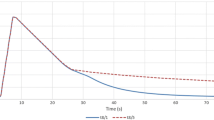Abstract
Warm pre-stressing of a cracked body can result in an apparent elevation of its fracture toughness at lower testing temperatures. This effect has been observed in mild steel pre-loaded at room temperature and tested at −150°C, when the apparent toughness elevation can be as great as a factor of two. This toughness elevation is produced both when the pre-load is maintained during cooling and when the pre-load is completely removed prior to cooling.
Crack tip stress distributions have been estimated for different warm pre-stressing histories by the superposition of the appropriate monotonic loading stress distributions. The Ritchie, Knott and Rice model of cleavage fracture and its associated fracture criterion have been used in conjunction with the crack tip stress distribution to predict the final fracture load after warm pre-stressing. Predictions so made are seen to be in good agreement with the experimental observations.
Résumé
La précharge à chaud d'un corps fissuré peut avoir comme conséquence une élévation apparente de la ténacité à la rupture aux températures d'essai les plus basses. Cet effet a été observé dans un acier doux présollicité à la température ambiante et essayé à −150°C et l'élévation apparente de la ténacité peut atteindre un facteur 2. Cette élévation de la ténacité produite à la fois lorsque la précharge est maintenue au cours du refroidissement et lorsque la précharge est complètement retirée avant le refroidissement.
La distribution des contraintes à l'extrémité de la fissure a été estimée pour différentes histoires de pré-contrainte à chaud par la superposition de distributions de contraintes monotoniques appropriées. Le modèle de Ritchie, Knott et Rice pour la rupture par clivage et le critère de rupture qui est associé. Ont été utilisés en conjonction avec la distribution des contraintes à l'extrémité de la fissure en vue de prédire la charge finale de rupture après pré-contrainte à chaud. Les prédictions ainsi faites sont en bon agrément avec les observations expérimentales.
Similar content being viewed by others
References
G.G. Chell, J.R. Haigh and V. Vitek, A theory of warm pre-stressing, experimental validation and the implications for elastic-plastic failure criteria, C.E.R.L. Note No. RD/L/N63/79.
R.D. Cheverton, S.K. Iskander and S.E. Bolt, Applicability of LEFM to the analysis of PWR vessels under LOCA-ECC thermal shock conditions, Oak Ridge National Laboratory ORNL/NUREG-40.
T.C. Harrison and G.D. Fearnehough, Transactions of the ASME, Journal of Basic Engineering, 94 (1972) 373–376.
D.A. Curry, Nature 276 (1978) 50–51.
D.A. Curry, Predicting the temperature and strain rate dependences of the cleavage fracture toughness of ferritic steels, C.E.R.L. Note No. RD/L/N75/79.
R.O. Ritchie, J.F. Knott and J.R. Rice, Journal of the Mechanics and Physics of Solids 21 (1973) 395–410.
D.A. Curry and J.F. Knott, Metal Science, 10 (1976) 1–6.
J.R. Griffiths and D.R.J. Owen, Journal of the Mechanics and Physics of Solids 19 (1971) 419–431.
E.F. Walker and M.J. May, Compliance Functions for various types of Test Specimen Geometry, BISRA Open Report MG/E/307/67.
British Standards Institute, Methods of test for plane strain fracture toughness (K IC) of metallic materials, B.S. 5447.
J.F. Knott and A.H. Cottrell, Journal of the Iron and Steel Institute 201 (1963) 249–260.
D.M. Tracey, Transactions of the ASME, Journal of Engineering Materials and Technology 98 (1976) 146–151.
D.M. Parks, Transactions of the ASME, Journal of Engineering Materials and Technology 98 (1976) 30–45.
J.R. Rice, in Fatigue Crack Propagation, ASTM Special Technical Publication 415 (1967) 247–309.
W.J. Ostergren, Master's thesis, Brown University (1969).
D.A. Curry, A comparison between two models of cleavage fracture, C.E.R.L. Note No. RD/L/N215/78.
G.G. Chell, A theory for predicting the failure loads of cracked structures subjected to warm pre-stressing, 1: load changes at constant temperature, C.E.R.L. Note No. RD/L/N78/79.
Author information
Authors and Affiliations
Rights and permissions
About this article
Cite this article
Curry, D.A. A micromechanistic approach to the warm pre-stressing of ferritic steels. Int J Fract 17, 335–343 (1981). https://doi.org/10.1007/BF00034507
Received:
Issue Date:
DOI: https://doi.org/10.1007/BF00034507




